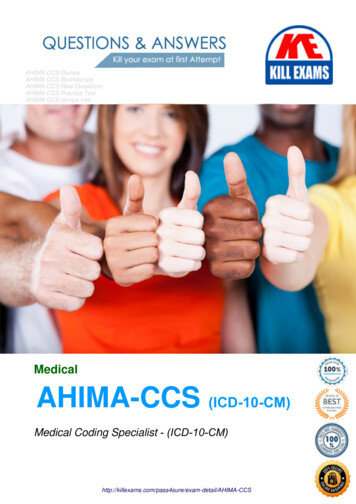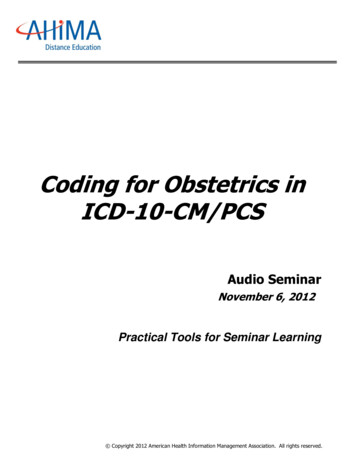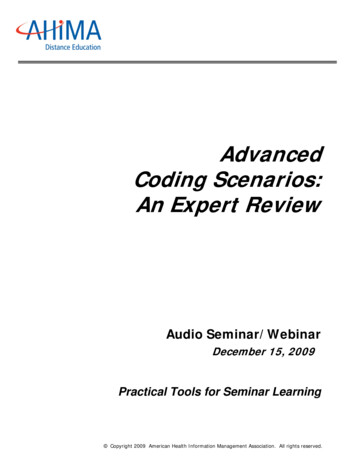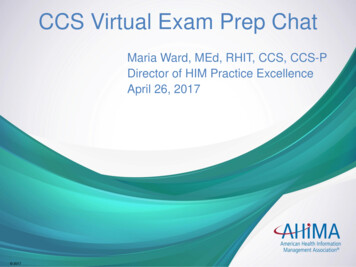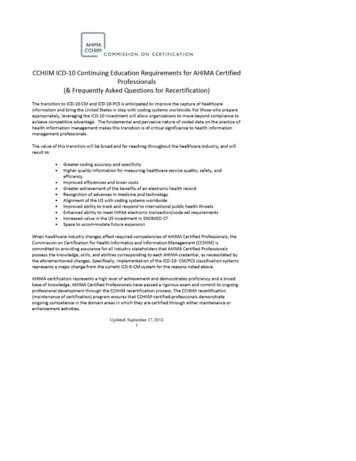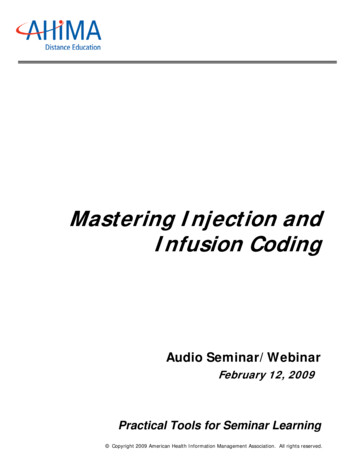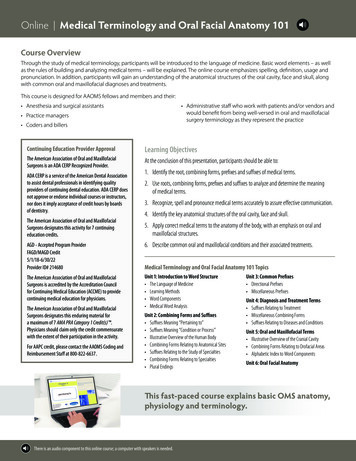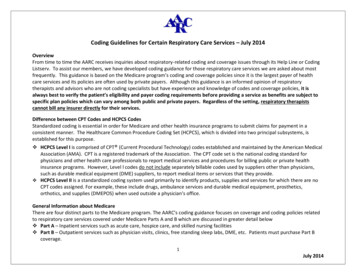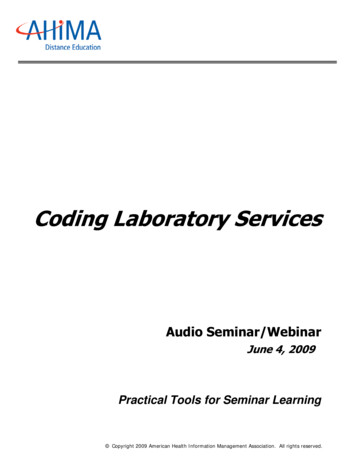
Transcription
Coding Laboratory ServicesAudio Seminar/WebinarJune 4, 2009Practical Tools for Seminar Learning Copyright 2009 American Health Information Management Association. All rights reserved.
DisclaimerThe American Health Information Management Association makes norepresentation or guarantee with respect to the contents herein andspecifically disclaims any implied guarantee of suitability for any specificpurpose. AHIMA has no liability or responsibility to any person or entity withrespect to any loss or damage caused by the use of this audio seminar,including but not limited to any loss of revenue, interruption of service, lossof business, or indirect damages resulting from the use of this program.AHIMA makes no guarantee that the use of this program will preventdifferences of opinion or disputes with Medicare or other third party payersas to the amount that will be paid to providers of service.CPT five digit codes, nomenclature, and other data are copyright 2009American Medical Association. All Rights Reserved. No fee schedules, basicunits, relative values or related listings are included in CPT . The AMAassumes no liability for the data contained herein.As a provider of continuing education the American Health InformationManagement Association (AHIMA) must assure balance, independence,objectivity and scientific rigor in all of its endeavors. AHIMA is solelyresponsible for control of program objectives and content and the selectionof presenters. All speakers and planning committee members are expectedto disclose to the audience: (1) any significant financial interest or otherrelationships with the manufacturer(s) or provider(s) of any commercialproduct(s) or services(s) discussed in an educational presentation; (2) anysignificant financial interest or other relationship with any companiesproviding commercial support for the activity; and (3) if the presentation willinclude discussion of investigational or unlabeled uses of a product. Theintent of this requirement is not to prevent a speaker with commercialaffiliations from presenting, but rather to provide the participants withinformation from which they may make their own judgments.The faculty has reported no vested interests or disclosures regarding thispresentation.AHIMA 2009 Audio Seminar Series http://campus.ahima.org/audioAmerican Health Information Management Association 233 N. Michigan Ave., 21st Floor, Chicago, Illinoisi
FacultyBetty Hatten, MHS, MTBetty Hatten is a manager in Huron Consulting Group’s Clinical Research Solutions andHealthcare Compliance practice. Ms Hatten is a 40 year veteran of the healthcareindustry, including the past 11 as a healthcare consultant focusing on coding andcompliance, charge capture, performance improvement, and chargemasterdevelopment and maintenance. A medical technologist for 28 years, her experienceincludes clinical laboratories, genetics and transplant labs, in vitro fertilization labs,educator, and laboratory administrative director.Diana Medal, MA, RHIA, CCS, CPC, CCS-PDiana Medal is a compliance practice leader in the care delivery section of KaiserPermanente’s national Compliance, Ethics, and Integrity team, where she isresponsible for coordinating coding compliance training and supporting codingcompliance audits. Ms Medal was previously assistant professor of health informationadministration at Loma Linda University. She also participated in global distanceinstruction for Loma Linda, as medical terminology instructor for physical andoccupational therapy students in Yokkaichi, Japan.AHIMA 2009 Audio Seminar Seriesii
Table of ContentsDisclaimer . iFaculty . iiThe Objectives . 1The Agenda . 1Comparison of Organ & Disease Panels . 2Lab Coding Tips . 3Online, Free, Lab Coding Reference . 4Using the Reference Lab Website . 4Coding Tip: Always Validate Testing Methods: Labs Vary . 52009 CPT Codes. 5-7HCPCS Code Selection . 7Polling Question #1 “Source of Diagnostic Information”. 8Official Coding Guidelines. 8Official Coding Guidelines Diagnostic Services Only .9-10Coding for Physician Billing Pathologist.10Proposed New Codes for FY 2010 .11Proposed Invalid Codes for FY 2010 .11Pathologist’s Interpretation of a Pap Smear .12Papanicolaou Test Reconfirmation V72.32 .12Abnormal Cytologic Smear of Anus 796.7 .13Other Codes Associated with Anal Pap Smear .13Diagnosis from Ordering Physician vs. Pathologist for Pathologist Claim .14Diagnosis for Urine Culture .14Diagnosis for Complete Blood Count (CBC) .15Diagnosis for Monitoring Effects of Long-term Use of Drugs .15Clinical Laboratory Fee Schedule . 16-17Physician Fee Schedule . 17-18Reimbursement for OPPS Hospital Lab Tests that are Assigned APCs .18Reimbursement for OPPS Hospital Labs.19Addendum B: OPPS Reimbursement .19Status Indicator Definitions .20Billing for End Stage Renal Disease (ESRD) Related Laboratory Tests . 20-21Composite Rate Tests .22Polling Question #2 “The Semicolon and Modifiers”.22National Correct Coding Initiative .23Do these 2 Indented Codes Need a Modifier? . 23-24Modifier -59 Distinct Procedural Service. 25-26Polling Question #3 “Use of Modifier -59”.26Modifier -91 Repeat Clinical Diagnostic Test .27-59 or -91 Case Study.28Modifier -90 Reference (Outside) Laboratory .29(CONTINUED)AHIMA 2009 Audio Seminar Series
Table of ContentsESRD Modifiers: CD, CE, CF . 29-30OIG Work Plan (FY 2009).30Why Doctors Order Lab Tests? .31Information Available for Each “Reason” .31The Need for ABNs: Variable .32Screening Tests: Legislative Provisions .32Beneficiary Notices Initiative (BNI) .33The CMSR 131 . 33-34ABN Instructions and Options .34Guidelines for Coding Blood Transfusions .35Complete Billing of the Blood Transfusion .35Transfusion Medicine Case: The Facts .36Transfusion Medicine Case: The Answer .36NCCI Edits for Crossmatching .37Transfusion Medicine Case: The Answer .37Most Common “Missed” CPT Codes in Lab: Microbiology .38Aerobic and Anaerobic Cultures with Blood Cultures . 38-39Most Common “Missed” CPT Codes in Lab: Microbiology . 39-40For More Information on Laboratory Coding from CPT Assistant . 40-41Resource/Reference List . 41-42Supplemental Material .43Other References : Lab Websites .43Audience Questions .44Audio Seminar Discussion .44Become an AHIMA Member Today! .45Audio Seminar Information Online .45Upcoming Audio Seminars .46Thank You/Evaluation Form and CE Certificate (Web Address) .46Appendix.47Resource/Reference List .48CE Certificate InstructionsAHIMA 2009 Audio Seminar Series
Coding Laboratory ServicesNotes/Comments/QuestionsThe ObjectivesAt the conclusion of today’s program, theparticipants will be able to:1.2.3.4.5.6.Select the most accurate lab CPT/HCPCS code;Locate internet resources for coding esoteric labprocedures and profiles;Identify the appropriate payment programs for OPlab services including ESRD composite rate, ClinicalLab Fee schedule and OPPS APCs;Discuss CPT coding guidelines for laboratoryservices;Summarize the ICD-9 CM Diagnostic Coding andReporting Guidelines for Outpatient Services; andDemonstrate the correct use of modifiers 59 and 91.1The Agenda1.2.3.4.5.6.CPT & HCPCS Coding Overview withCoding TIPS and CAUTIONSICD-9 Diagnosis & Procedure CodingThe Fee Schedules and Addendum BLab Modifier Maze and the NCCIOIG & the Clinical Lab: ComplianceGuidelines and the 2009 Work PlanDeep Dive into Real Life Lab CodingCasesAHIMA 2009 Audio Seminar Series21
Coding Laboratory ServicesNotes/Comments/QuestionsComparison ofOrgan & Disease Panels3Comparison ofOrgan & Disease Panels4AHIMA 2009 Audio Seminar Series2
Coding Laboratory ServicesNotes/Comments/QuestionsLab Coding Tips Select Accurate 80000 Codes Adjectives and other important wordsSpecimen , Method, Total or Free, With orW/out Manual or automated, Qual or Quant, initial, Each, first, “2-8” or “9-15” Antibody codes start with 86xxx; Antigensstart with 87xxx 5Lab Coding Tips When you need more than one codeCharge explosions Panels , Profiles and Reflex Tests:Maintaining Compliance When there isn’t a codeAvoid the unlisted procedure code: UseMethod Codes How to find esoteric testing codes 6AHIMA 2009 Audio Seminar Series3
Coding Laboratory ServicesNotes/Comments/QuestionsOnline, Free, Lab Coding ReferenceType yourQuery or selectfrom thealphabet7Using the Reference Lab WebsiteQueried“Drug Screen”8AHIMA 2009 Audio Seminar Series4
Coding Laboratory ServicesNotes/Comments/QuestionsCODING TIP: Always ValidateTesting Methods: Labs Vary92009 CPT Codes 83876 Myeloperoxidase (MPO) A biomarker used in conjunction withtroponin, CK or CKMB and BNP. ID’spatients w/chest pain who are at risk forMI but have a negative troponin or ECG.83951 Oncoprotein (DCP) Oncoprotein biomarker intended for F/Uof patients w/chronic liver disease at riskfor Hepatocellular carcinoma. (Associatedw/a 4.8 increase of HCC w/in next 21months)10AHIMA 2009 Audio Seminar Series5
Coding Laboratory ServicesNotes/Comments/Questions2009 CPT Codes 85397 Coagulation & Fibrinolysis,functional activity, NOS, each analyte Used in Dx of thrombotic thrombocytopenicpurpura & hemolytic uremic syndrome(examples of assays i.e., Disintegrin andmetalloproteinase)87905 Infectious agent enzymatic activityother than virus (e.g., sialidaseactivity in vaginal fluid) The test is for bacterial vaginosis with results inapprox 10 minutes. Has a reported sensitivity of90%112009 CPT ChangesThe old subheading following 83999“Transcutaneous Procedures” was deletedin 2009 and replaced with the newsubheading “In Vivo (e.g. transcutaneous)Laboratory Procedures. The new codesare: 88720 Bilirubin, total transcutaneous 88740 Hemoglobin, quantitative,transcutaneous, per day;carboxyhemoglobin 88741 Methemoglobin12AHIMA 2009 Audio Seminar Series6
Coding Laboratory ServicesNotes/Comments/Questions2009 CPT Changes Molecular diagnostics codes 83890-83909were revised in 2009. These codesrepresent molecular diagnostic techniquesfor analysis of nucleic acids. Code separately each procedure used in theanalysis. Additional descriptions were added, forexample, “each nucleic acid type (i.e., DNAor RNA),” “each enzyme treatment,” and“each nucleic acid preparation.”13HCPCS Code Selection Select Accurate HCPCS Codes The Blood Products P9010 - P9060; J2788 - J2792 Adding on a 80000 Code to a blood product CAUTION: Do not unbundle or double bill14AHIMA 2009 Audio Seminar Series7
Coding Laboratory ServicesNotes/Comments/QuestionsPolling Question #1“Source of Diagnostic Information”A diagnosis was not on the lab order.Can the lab staff accept the patient’sreason for why the test has beenordered?[*1] Yes[*2] No15Official Coding Guidelines Diagnostic Coding and ReportingGuidelines for Outpatient Services Coding guidelines for inconclusivediagnoses (probable, suspected, rule out,etc.) were developed for inpatientreporting and do not apply tooutpatients.16AHIMA 2009 Audio Seminar Series8
Coding Laboratory ServicesNotes/Comments/QuestionsOfficial Coding GuidelinesDiagnostic Services Only Patients receiving diagnostic servicesonly For patients receiving diagnostic servicesonly during an encounter/visit, sequencefirst the diagnosis, condition, problem, orother reason for encounter/ visit shownin the medical record to be chieflyresponsible for the outpatient servicesprovided. Codes for other diagnoses maybe sequenced as additional diagnoses.17Official Coding GuidelinesDiagnostic Services Only For encounters for routine laboratorytesting in the absence of signs,symptoms, or associated diagnosis,assign V72.6. If routine testing is performed during thesame encounter as a test to evaluate asign, symptom, or diagnosis, it isappropriate to assign both the V code andthe code describing the reason for thenon-routine test.18AHIMA 2009 Audio Seminar Series9
Coding Laboratory ServicesNotes/Comments/QuestionsOfficial Coding GuidelinesDiagnostic Services Only For outpatient encounters for diagnostictests that have been interpreted by aphysician, and the final report is availableat the time of coding, code any confirmedor definitive diagnosis(es) documented inthe interpretation. Do not code relatedsigns and symptoms as additionaldiagnoses. Note: This differs from thecoding practice in the hospital inpatientsetting regarding abnormal findings ontests.19Coding forPhysician Billing Pathologist Coding Clinic First Quarter 1990 Page: 15-16 When patients receive only ancillary diagnosticservices during an encounter, the appropriate Vcode for the examination is sequenced first.The diagnosis/problem for which the servicesare being performed is sequenced second. V72.6 Laboratory examination is used often bypathologists to describe the reason for theencounter (e.g. study biopsy specimen). Whenthe bill is submitted, if there is an establisheddiagnosis (e.g. malignant neoplasm) then anadditional code can be submitted for thediagnosis.20AHIMA 2009 Audio Seminar Series10
Coding Laboratory ServicesNotes/Comments/QuestionsProposed New Codes for FY 2010V72.60Laboratory examination, unspecifiedV72.61Antibody response examinationV72.62Laboratory examination ordered aspart of a general medicalexaminationV72.63Pre-procedural laboratoryexaminationV72.69Other laboratory examination21Proposed Invalid Codes for FY 2010V72.6Laboratory examination22AHIMA 2009 Audio Seminar Series11
Coding Laboratory ServicesNotes/Comments/QuestionsPathologist’s Interpretationof a Pap SmearScenario: Physician performed a routinegynecological examination with a pap smear.The specimen was sent to an external lab.Conclusion: The pathologist’s interpretation ofthe pap smear revealed abnormal cells andbacterial vaginosis.Code Assignment: V72.6 as the first listeddiagnosis followed by 616.10.Rationale: Pathology claims should start withV72.6. The secondary diagnosis coderepresents any definitive diagnosticinformation.23Papanicolaou Test ReconfirmationV72.32 V72.32 Encounter for Papanicolaou CervicalSmear to Confirm Findings of Recent NormalSmear Following Initial Abnormal Smear This code is assigned by the gynecologist andnot the pathologist. It is routine for patients to return for severalPap tests following an initial abnormal Papsmear. 1st Pap as part of routine GYN ExamV72.31. If abnormal, 2nd pap 795.0x. Whenresult of 2nd Pap is normal, Third pap test isV72.32, and 4th pap test is V72.32.24AHIMA 2009 Audio Seminar Series12
Coding Laboratory ServicesNotes/Comments/QuestionsAbnormal Cytologic Smear of Anus796.7 796.7x may be assigned as a secondary diagnosiscode by the pathologist for abnormal cytologicsmear of anus and anal HPV. V72.6 is principaldiagnosis for pathologist. Human papillomavirus (HPV) can occur in the anusand is associated with a higher incidence of analcancer in HIV patients compared to the generalpopulation. Pap smears are also performed for cytologicevaluation of the anus, and similar to cervicalcytology, anal cytology uses the Bethesda 2001system to categorize the abnormalities byseverity.25Other Codes Associated withAnal Pap Smear V76.49 Screening for malignantneoplasm of other sites 796.77 Satisfactory anal smear butlacking transformation zone 796.78 Unsatisfactory anal cytologysmear26AHIMA 2009 Audio Seminar Series13
Coding Laboratory ServicesNotes/Comments/QuestionsDiagnosis from Ordering Physicianvs. Pathologist for Pathologist ClaimScenario: A physician surgically removed askin lesion. The specimen was sent to thepathologist to determine the nature of thelesion.Conclusion: The pathologist confirmed thelesion to be malignant.Code Assignment: The pathologist wouldreport the appropriate malignancy codedependent on the anatomical site and themorphology of the neoplasm on his claim.Rationale: The pathologist is a physician.27Diagnosis for Urine Culture(Note: See Supplemental Materials for Urine Culture Flow Chart)Scenario: A physician ordered a urinaryculture for a patient experiencing sharp pelvicpains, a burning sensation in the urethra, andurine tinged with blood. The physician sentthe urine sample to the lab.Conclusion: The culture was positive for aurinary tract infection (UTI).Code Assignment: The lab would report thecode(s) to describe the symptoms.Rationale: The urine culture did not havephysician interpretation.28AHIMA 2009 Audio Seminar Series14
Coding Laboratory ServicesNotes/Comments/QuestionsDiagnosis forComplete Blood Count (CBC)Scenario: A physician orders a CBC for apatient c/o frequent headaches andlethargy. The blood sample was sent to anexternal lab.Conclusion: The findings were lowhemoglobin and hematocrit.Code Assignment: the lab would report thecode(s) to describe the symptoms.Rationale: The blood sample did not havephysician interpretation.29Diagnosis for Monitoring Effects ofLong-term Use of Drugs Assign a code from category V58.6x forpatients requiring laboratory monitoring toasses the effects of Long-term (current) druguseMonitoring for Long-term (current) use of othermedications (i.e., chemotherapy, digitalis)V58.69 as the principal diagnosis Monitoring for Long-term (current) use ofwarfarin/Coumadin V58.61 Monitoring for Long-term (current) use ofaspirin V58.66 Monitoring for Long-term (current) use ofsteroids V58.6530 AHIMA 2009 Audio Seminar Series15
Coding Laboratory ServicesNotes/Comments/QuestionsClinical Laboratory Fee ScheduleLog on to the CMS websiteat:http://www.cms.hhs.gov/Scroll down, on the righthand side click “Medicare‐Fee‐for‐Service Payment” Then click “Medicare” Then click “ClinicalLaboratory FeeSchedule”In the left hand column,click “Fee Schedule” Clinical Laboratory FeeSchedule – Home31Clinical Laboratory Fee Schedule32AHIMA 2009 Audio Seminar Series16
Coding Laboratory ServicesNotes/Comments/QuestionsClinical Laboratory Fee Schedule33Physician Fee ScheduleLog on to the CMS websiteat:http://www.cms.hhs.gov/Scroll down, on the righthand side click “Medicare‐Fee‐for‐Service Payment” Then click “Medicare” Then click Physician FeeSchedule”In the left hand column,click “Fee Schedule” Physician Fee Schedule –HomePhysician Fee SchedulePhysician Fee ScheduleOverview34AHIMA 2009 Audio Seminar Series17
Coding Laboratory ServicesNotes/Comments/QuestionsPhysician Fee Schedule35Reimbursement for OPPS HospitalLab Tests that are Assigned APCsLog on to the CMS websiteat:http://www.cms.hhs.gov/Scroll down, on the righthand side click “Medicare‐Fee‐for‐Service Payment” Then click “Medicare”In the left hand column,click “Addendum A andAddendum B Updates” Then cllick “HospitalOutpatient PPS” Addendum B April 2009Hospital Outpatient PPSAddendum A and Addendum B Updates36AHIMA 2009 Audio Seminar Series18
Coding Laboratory ServicesNotes/Comments/QuestionsReimbursement forOPPS Hospital Labs37Addendum B: OPPS ReimbursementStatus Indicatoridentifiesreimbursementmethod38AHIMA 2009 Audio Seminar Series19
Coding Laboratory ServicesNotes/Comments/QuestionsStatus Indicator DefinitionsClick Tab and Scroll39Billing for End Stage Renal Disease(ESRD) Related Laboratory Tests40.6 - Medicare Publication 100- 4Chapter 16(Rev. 1, 10-01-03) PM AB-98-7, PRM 12711, B3-4270.2 Hemodialysis, Intermittent PeritonealDialysis (IPD), and Continuous CyclingPeritoneal Dialysis (CCPD) Tests40AHIMA 2009 Audio Seminar Series20
Coding Laboratory ServicesNotes/Comments/QuestionsBilling for End Stage Renal Disease(ESRD) Related Laboratory Tests With some exceptions, laboratory tests forhemodialysis, intermittent peritonealdialysis (IPD), and continuous cyclingperitoneal dialysis (CCPD) are included inthe ESRD composite rate. For a particulardate of service to a beneficiary, if 50percent or more of the covered laboratorytests are noncomposite rate tests Medicareallows separate payment beyond thatincluded in the composite rate.41Billing for End Stage Renal Disease(ESRD) Related Laboratory Tests For a description of what laboratory testsand other tests are included in thecomposite rate and under what conditionssuch tests may qualify for additionalpayment in addition to the composite rate,see the Medicare Benefit Policy ManualChapter 11, “End Stage Renal Disease(ESRD),” and Chapter 8 of this manual. Clinical diagnostic laboratory tests includedunder the composite rate payment are paidthrough the composite rate paid by the FI.42AHIMA 2009 Audio Seminar Series21
Coding Laboratory ServicesNotes/Comments/QuestionsComposite Rate Tests43Polling Question #2“The Semicolon and Modifiers”The placement of the semicolon in theCPT description is an indication for theneed of a modifier?[*1] True[*2] False44AHIMA 2009 Audio Seminar Series22
Coding Laboratory ServicesNotes/Comments/QuestionsNational Correct Coding Initiative The CMS National Correct CodingInitiative (NCCI) edits provide manyspecific instructions for use of CPTmodifiers used for laboratory services. If an NCCI flag is reported on a claim,consider that modifiers may be added toremove the NCCI edit if the procedure isdistinct or unrelated to other proceduresperformed on the same date.45Do these 2 Indented Codes Need aModifier?46AHIMA 2009 Audio Seminar Series23
Coding Laboratory ServicesNotes/Comments/QuestionsDo these 2 Indented Codes Need aModifier?2 commonmethods forsusceptibilitytesting47Do these 2 Indented Codes Need aModifier?48AHIMA 2009 Audio Seminar Series24
Coding Laboratory ServicesNotes/Comments/QuestionsModifier -59Distinct Procedural Service -59 is used to identifyprocedures/services that are notnormally reported together, but areappropriate under certaincircumstances. -59 is used to designate instanceswhen distinct and separate multipleservices are provided to a patient on asingle date of service.49Modifier -59Distinct Procedural Service-59 is only to be used if no moredescriptive modifier is available -59 is used for separate sessions orpatient encounters, or differentprocedures. -59 is used if the same procedureusing the same procedure code is usedfor testing a different specimen (e.g.aerobic culture of two independentwound site specimens). 50AHIMA 2009 Audio Seminar Series25
Coding Laboratory ServicesNotes/Comments/QuestionsModifier -59Distinct Procedural Service -59 is NOT used when a test is orderedand performed and additional relatedprocedures are necessary to provide orconfirm the result. These would beconsidered part of the ordered test. Example – A patient has an abnormaltest result and repeat performance of thetest is done to verify the result. Only oneunit of service of the test may bereported.51Polling Question #3“Use of Modifier -59”Is modifier -59 used with flowcytometry involving 88184 and 88185x 3?[*1] Yes[*2] No52AHIMA 2009 Audio Seminar Series26
Coding Laboratory ServicesNotes/Comments/QuestionsModifier -91Repeat Clinical Diagnostic Test -91 is used to identify repeatperformance of the same laboratorytest on the same day to obtainsubsequent (multiple) test results. For example, if a second culture wasperformed from the same wound siteon the same day, -91 is appended.53Modifier -91Repeat Clinical Diagnostic Test-91 is NOT used when tests are re-runto confirm initial results due to testingproblems when a normal, one-timereportable result is all that is required. -91 is NOT used when other CPT codesare available to describe series ofresults (e.g. glucose tolerance tests,evocative/suppression testing). 54AHIMA 2009 Audio Seminar Series27
Coding Laboratory ServicesNotes/Comments/Questions-59 or -91 Case StudyA female patient is seen in theoutpatient laboratory for aerobic cultureof two sites of a single wound of the leftarm. The lab technologist obtainsindependent specimens, one from theproximal, and one from the distal woundsite. 87071 is coded x 2 for quantitativeaerobic bacterial culture. What modifieris appended to the second code?55-59 or -91 Case StudyA male patient with hypokalemia hadmultiple blood tests performed to checkpotassium following potassiumreplacement therapy. After the initialpotassium value, three subsequentblood tests were performed on the samedate following the administration ofpotassium to correct the patient’shypokalemic state. 84132 x 2 is codedfor serum potassium. What modifier isappended to the second code?56AHIMA 2009 Audio Seminar Series28
Coding Laboratory ServicesNotes/Comments/QuestionsModifier -90 Reference (Outside)Laboratory When laboratory procedures areperformed by a party other than thetreating or reporting physician, theprocedure may be identified by addingmodifier -90 to the usual procedurenumber. Although the physician is reportingthe p
Coding Laboratory Services AHIMA 2009 Audio Seminar Series 3 Notes/Comments/Questions Lab Coding Tips Select Accurate 80000 Codes Adjectives and othe r important words Specimen , Method, Total or Free, With or W/out Manual or automated, Qual or Quant, initial, Each, first, "2-8" or "9-15" Antibody codes start with 86xxx; Antigens
